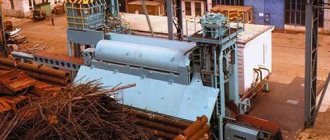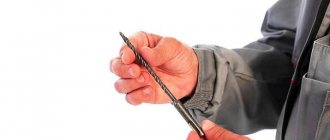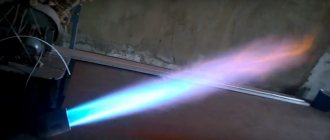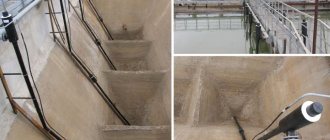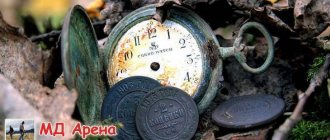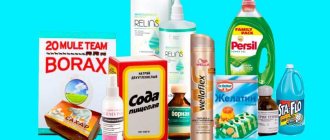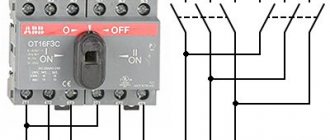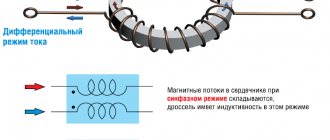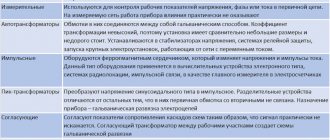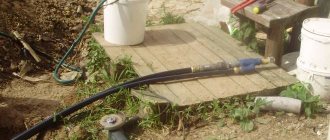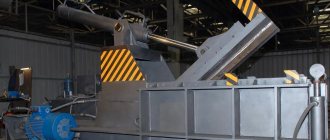Borax (sodium tetraborate) Na 2 B 4 O 7 . H 2 O is a salt of tetraboric acid. Ordinary borax (hydrate decahydrate) forms large, colorless, transparent prismatic crystals; base-centered monoclinic lattice, a = 12.19 Å, b = 10.74 Å, c = 11.89 Å, ß = 106°35´; density 1.69 - 1.72 g/cm 3 ; In dry air, the crystals erode from the surface and become cloudy. When heated to 80 ° C, decahydrate (from the Greek deka ten - in complex words means ten, tenfold) loses 8 molecules of water, at 100 degrees slowly, and at 200 ° C another water molecule quickly splits off, in the range of 350-400 ° Complete dehydration occurs.
Solubility of borax (in anhydrous salt per 100 g of water): 1.6 (10°C), 3.9 (30°C), 10.5 (50°C). The saturated solution boils at 105 °C.
Borax hydrolyzes in water, so its solution has an alkaline reaction. It dissolves in alcohol and glycerin. Completely decomposes with strong acids:
With the oxides of some metals, borax produces colored borates (“borax pearls”):
which is used in analytical chemistry to discover these metals.
When a solution of ordinary borax is slowly cooled at 79 ° C, the octahedral borax Na 2 B 4 O 7 begins to crystallize. 5H 2 O (or “jewelry borax”), with a density of 1.815 g/cm 3, stable in the range 60 - 150 ° C. The solubility of this borax is 22 g per 100 g of water at 65 ° C, 31.4 at 80°C and 52.3 at 100°C.
Borax is the most important flux that facilitates the smelting process. When cooled, molten borax forms a glaze on the walls of the crucible, protects the melt from oxygen and dissolves metal oxides.
Slow thermal dehydration of ordinary borax produces pyroborax with a density of 2.371 g/cm3 and a melting point of 741 ° C. Borax melts and breaks down into sodium metaborate and boron trioxide, which mix in a liquid state:
Boron oxide, combining with metal oxides, forms metaborates in the same way as boric acid. Sodium metaborate easily mixes with newly formed metaborates and quickly removes them from the molten metal zone, and new active boron oxide molecules take their place. Borax has a greater ability to dissolve oxides than boric acid, and is used not only as a melting reducing flux, but also as the most important flux for brazing.
Ordinary borax is obtained from boric acid, from tincal, kernite and some other minerals (by recrystallization), as well as from salt lake water (by fractionated crystallization).
Borax is widely used in the preparation of enamels, glazes, in the production of optical and colored glasses, in welding, cutting and soldering of metals, in metallurgy, electroplating, dyeing, paper, pharmaceutical, leather production, as a disinfectant and preservative and fertilizer.
There are many types of solders used during soldering. Each of them has its own advantages, which makes it useful for a particular area. Drill brazing flux is often used for soldering difficult metals such as cast iron, steel or copper, but can also be useful for other procedures. This is one of the most common and time-tested fluxes that are used both in the industrial sphere and in the private sector. Soldering borax is relatively inexpensive and can be used for many types of soldering. It gives a complex effect, which simplifies the process and does not require the addition of other components, although in the jewelry industry there are also more complex fluxes based on it.
Copper soldering borax
A drill for brass soldering helps not only improve the soldering properties of metal, but also clean its surface from excess films, deposits and other things that can damage a high-quality and reliable connection. In its pure form, it is a high-temperature flux, the melting point of which is approximately 700-900 degrees Celsius. But the properties of the material allow it to be easily dissolved in water, resulting in a softer flux. The degree of dissolution determines how high the melting point of the material will be. Over the course of its existence, soldering specialists have come up with many ways to use and create combinations for this material. Soldering borax is produced in accordance with GOST 8429-77.
Description and external signs
Borax mineral is an aqueous sodium borate with hydroxyl. It is also popularly known as boric salt. In Asian countries it is called tincal. This substance resembles almost colorless crystals. Origin of the name: from the Arabic word bauraq - translated as “white”. The form of release of borax in pharmacies and hardware stores is a white fine-crystalline powder.
Chemical composition
The components of borax are the sodium salt of boric acid and a strong base (water, sodium). Chemical formula: Na2(B4O5)(OH)4 8H2O
The practical significance of borax is to serve for the extraction of boron.
Molecular weight of the substance: 381.37; Density: 1.7; Specific gravity: 1.69 – 1.8; Maximum birefringence: δ=0.025; IMA classes: borates.
Soldering brass - a reliable connection at home
A weighed portion of technical borax 0 4596 g, titrated with a solution of HC1 with R0 1062, 21 20 ml was consumed. [4]
Industrial drill supplied by industry contains hygroscopic and crystallization moisture, which, when entering the weld pool, sharply increases the gas porosity of the weld metal. In addition, part of the borax, when moisture evaporates from it, foams and is blown out by the flame, as a result of which areas of the metal are exposed and oxidized. [5]
Borax is obtained from common technical borax (Na2B4O7 - 10H2O) after calcination in an oven at a temperature of 700 - 800 C on a stainless steel baking sheet or in an open fireclay crucible filled with ciu in height at V, due to the strong swelling of borax when heated. After calcination, the borax is ground in a mortar or ball mill. This borax should be stored in a hermetically sealed jar. [6]
For the production of 1 ton of technical borax containing 99 0 - 99 8% Na2B4O7 - 10H2O, 0 9 - 1 t of boron-calcite (40 - 42% B2O3), 0 14 - 0 18 g of soda, 0 10 - 0 15 t of bicarbonate are consumed and 0 01 g of bleach. [8]
To obtain calcined borax, technical borax is poured into an open porcelain or fireclay crucible at 1/10 of its height and placed in an oven at 700 - 750 C. After swelling and settling, the borax is ground into powder in a ball mill or mortar and stored in vessels with an airtight lid before use. [9]
Experimental work carried out at TatNIPIneft showed the possibility of using technical drill as an indicator element for identifying oil-bearing reservoirs flooded with injected fresh or formation water based on different rates of dissolution of the penetration zone. [10]
The temporary compressive strength of gypsum NBSS samples with the addition of 2 25 and 2 50% technical borax is given below. [eleven]
To sustainably maintain the pH value of the drilling fluid, starting from a depth of 5600 m until the end of drilling, it was decided to use technical borax, and soda ash to precipitate calcium and magnesium ions. [12]
Sulfonol, Progress, ANP-2 and a mixture of surfactants (OP-7 sulfonol), reagents (CMC and KSSB), as well as technical borax were tested as retarders for the gypsum solution. However, only with the introduction of borax was the required strength of the gypsum stone obtained. [14]
They produce technical and food grade borax. Technical borax is obtained by reacting boric acid and soda in a boiling solution. After separating the sludge on a filter, borax crystallizes from the cooled solution, which is separated in a centrifuge and washed. Food grade borax is obtained by recrystallizing industrial borax. [15]
Read also: Steel grade 15xsnd decoding
Area of application of borax
This substance has found a wide range of applications and is actively used in various industries:
- In industry. In welding production it is used as a component of flux. It is also used for the production of glaze, glass and enamel. In mechanical engineering, this substance is used for the production of antifreeze, lubricants and brake fluids. For disinsection (insect control) at home, it is used as a toxic substance.
- In the textile industry. Treat the surface of the fabric before dyeing.
- In jewelry production. It is used as a flux for soldering metals. It is used to clean the surface of the metal so that the connection is strong. It is used when working with brass, silver and gold.
- In medicine. In this area, this substance is used to combat fungi. For this purpose, preparations from borax in glycerin are prescribed. It is considered a high-quality antiseptic, not inferior in its characteristics to copper sulfate and tannin. It can also be found in pharmacies as a solution of boric acid.
- In cosmetology. This substance is included in almost all cosmetic products. This is explained by its ability to soften hard water and serve as a preservative that extends the shelf life of masks, creams, shower gels, shampoos, etc.
- In soap making. This substance is found in bath bombs. This product owes its effervescent effect to the borax contained in it.
Use of borax in everyday life
This substance is actively used not only in production, but also in everyday life, in some cases it turns out to be irreplaceable. It is used as:
- All-purpose detergent. To do this, take two teaspoons of borax and dissolve them in two glasses of water. Store the substance in a closed container and add small amounts to water when cleaning furniture, washing floors, and windows.
- Insect and rodent control products. Many people know the good old method, passed down from generation to generation, with balls of potato or egg yolk and boric acid. For domestic insects, such a ball serves as real poison. With this method, it is important that insects do not have access to water, otherwise all efforts will be in vain. To control rodents, the powder is scattered along the baseboard on the floor.
- Mold control products. Due to excess moisture and evaporation, mold often appears in the bathroom. This substance will come to the rescue here too. This product can only be used on surfaces without paint, otherwise it will simply peel off. Borax is mixed with water to form a thick, paste-like consistency. Simply apply the mixture in a thick layer to the mold and leave overnight. In the morning, the mixture is removed from the surface, leaving the walls clean.
- Products to combat rust and limescale. Sometimes even expensive products cannot cope with limescale on the sink or toilet. This substance will help in this case too. For this purpose, it is recommended to pour a glass of borax into the toilet bowl and clean the earthenware with a brush in the morning. All stubborn stains will disappear without leaving a trace.
You can buy borax at a pharmacy under the name “Boric acid solution” . The powder can be purchased at a hardware store or searched online on specialized sites.
A kilogram of borax for technical purposes will cost about 150-200 rubles. In large quantities it can be purchased in packs of 25 kg. The pharmacy chain sells an aqueous solution. Its cost can vary from 14 to 100 rubles, depending on the region of residence. It is bottled in bottles with a capacity of 30 to 100 milliliters.
How is the soldering process performed?
When performing soldering at home, you need to understand one subtlety. When borax has been stored in powder for a long time, it is better to melt it first, for which a crucible or fireclay is used. The resulting substance should be crushed into a powder and placed for storage in an airtight container.
Tightness is a prerequisite: the powder is hygroscopic, and due to the presence of moisture in the flux, slags with metal can form.
Before applying flux, the soldering area is heated red-hot. It is better to heat not the soldering area itself, but next to it, gradually transferring the heat to the junction of the elements. When the parts have warmed up, the joint should be sprinkled with a small amount of borax. At the same time, monitor the temperature, wait until the borax melts well and spreads over the soldering area in the form of a film.
It is better to solder with brass, the rod is dipped in borax, after which you need to wait for the powder to melt. The flame that the soldering torch emits should be close to the soldering area, but you don’t need to hold it like that for long. This way you can get a connection with slag and a layer of scale, which will be difficult to remove. Immediately before the solder is applied, the soldering area should be red and the melted borax should be bluish. This moment can be considered optimal for adding solder.
Next, a solder bar coated with borax powder must be brought to the soldering site and heated to the temperature at which the solder begins to melt (in the case of brass, until it glows orange). The melting point of brass and borax is almost the same. Next, the actual work process begins.
Read also: Screwdriver voltage tester how to use
Flaws
- After use, a deposit of salts forms, which must be removed mechanically;
- It is necessary to choose storage areas that are free of moisture, since high humidity will cause the flux to deteriorate;
- To prepare the material for use, you need to spend time and choose the right proportion, which can lead to errors.
Varieties of Borax
There are two main varieties that relate to the appearance of the material. The first option is the solid form. Borax soldering flux is supplied in the form of a powder with fine solid fractions. Thanks to this, it is easy to lay it on the metal surface before soldering in the required quantity and it will not spread at the same time. This variety is supplied in a special box that protects the material hermetically from the penetration of moisture and other foreign factors. Fractions are white.
Soldering borax in powder form
The second type, which is more often used for lighter metals and their alloys, is diluted borax. In this case, you are offered the same material, but dissolved in liquid. Due to this, it can be used at lower soldering temperatures. Using this type is also easier, since small parts are simply dipped into the liquid, after which they can be soldered. This is used both in the jewelry industry and in other places where small items are worked. Contacts, wires and other types of equipment come into good contact with dissolved flux. Despite the fact that the principle of using borax for soldering in liquid form is somewhat different from the standard one, they have almost the same effect.
There are also varieties in the form of mixtures, when other fluxes are also used. This is necessary in cases where it is impossible to achieve the desired results using one substance. Proportions and composition depend on specific goals. Most often it is combined with boric acid.
Composition and physicochemical properties
The composition of borax for soldering includes sodium chloride and barium chloride, in some cases boric acid is added to it. It is not used in its pure form for all procedures, since this would require too high a melting point. Drill soldering powder is a high-temperature flux, so its main property is resistance to high temperatures. It is worth noting that the material perfectly retains its chemical properties even at a lower concentration than what is supplied. Thus, the flux solution has a fairly high level of dissolution of the oxides of all base metals for which it is used.
It can also dissolve fatty films and other unnecessary things that will interfere with the normal soldering of the material. Brown soldering protects against many types of defects that can occur in work.
Specifications
There are two main grades of the substance, which are defined according to GOST as grade A and grade B:
Soldering of metals is carried out by first removing traces of oxides from their surface. Fluxes are used for this. They should prevent oxidation when heated and encourage good flow of molten solder.
For soldering copper products, borax solder ideally meets all requirements. The substance has been known since the Middle Ages. It was mined in the lakes of India and Tibet, then transported to Europe, where it was used for processing fabrics and leather, and producing glass.
Borax is widely used for working with metals. When manufacturing or repairing metal products, borax soldering is carried out. First of all, the method is used for parts made of copper and brass. A special type of this flux is used when repairing jewelry.
Side effects
A side effect to the drug can only appear if there is a high sensitivity to the components.
These include:
- Itching
- Weakness
- Possible skin rashes
- Convulsions
- Digestive disorders
- Dermatitis
- Failure of the menstrual cycle
- Abdominal pain
- Cardiopalmus
- Anemia
You should stop using this drug if you experience any side effects and seek immediate medical attention.
Contraindications
- Mechanical damage to the skin and mucous membrane
- Breastfeeding and pregnancy
- Hypersensitivity to individual components of the drug component
- Drug intolerance
Composition and properties
The exact origin of the historically established, trivial name has not been fully clarified. According to the chemical nomenclature, borax is a crystalline hydrate of the sodium salt of tetraboric acid.
If the composition contains 10 water molecules, then the substance is called sodium tetraborate decahydrate. There are types of crystalline hydrate with five water molecules.
They are called sodium tetraborate pentahydrates. Strictly speaking, the composition of borax is a salt surrounded by a hydration shell of 10 water dipoles.
At 64 ℃, the decahydrate melts and gradually loses water. Complete dehydration of borax occurs at 380°. The resulting tetraborate withstands heating up to 742° and only then melts.
This gradual melting of borax is somewhat confusing to ordinary consumers who are accustomed to the fact that the substance melts strictly at one temperature value. The specificity is explained by the presence of water molecules in the crystalline hydrate. This feature simplifies the use of borax for soldering.
The quality of the substance is standardized by the state standard. There are two grades of raw materials that represent technical borax:
- Grade A is 99.5% salt decahydrate. The remaining 0.5% consists of carbonates, sulfates, and tiny amounts of lead and arsenic compounds;
- grade B - 94% decahydrate, the impurity content of which is 6%.
Both brands are not very stable. The shelf life of technical borax should not exceed six months. It is recommended to use grade B borax as a flux. It fully meets the soldering requirements and is cheaper than grade A raw materials.
Analysis progress
1. Preparation of a problem solution for analytical operations consists in accurately bringing the volume of its solution with distilled water to the MARK level. MIX!.
(Put MK0.1l on the workplace!)
2. Preparation of ≈0.1 N solution of BORAX in a selected volumetric flask - 200 ml or 250 ml:
a) Calculation of a sample of crystalline borax (Na2B4O7.10H2O):
CH(Na2B4O7) » 0.1n = m(BOROX) / Me(BOROX). V( selected volumetric flask)
m(weight of borax) » 0.1. 190.7. V( selected volumetric flask):
— for V( selected volumetric flask) = 0.2 l
m(weight)200 ≈ 0.1. 190.7. 0.2 = 3.81g ≈3.5-4.2g
- for V ( selected volumetric flask) = 0.25 l
m(weight)250 = 0.1. 190.7. 0.25 = 4.76g ≈4.5-5.2g
b) Preparation of standard working solution:
Choose a 200ml or 250ml volumetric flask. and wash it thoroughly!
-insert a special funnel into the selected volumetric flask ,
- on the scales in a small glass, take the mass of a WEIGHT of borax for the selected volumetric flask:
| Empty cup weight | G |
| Mass of a glass with a crystalline substance | G |
| m( "weight ) | G |
- carefully , using a special funnel, washing it with small portions of hot distilled water, quantitatively transfer this sample inside the volume of the selected volumetric flask, filling it HALF,
-cool the flask solution to ROOM temperature,
- bring the volume of the flask with cold distilled water to the MARK on its neck.
Mix the solution in a selected flask - on a paper "apron" indicate - BORAHO,
place the volumetric flask with the prepared borax solution on your workplace!
c) Calculation of the exact normality of the prepared borax solution:
Sn(borax) = m(weight) / [ 190.7. V( selected volumetric flask ) ] = 0, n.
3. Preparation of ≈0.1 N solution of SULFURIC ACID BY DILUTING a more concentrated one:
a) Measure the density of a concentrated solution of H2SO4, conc.,
... from the table in APPENDIX VII (pages 467-468) determine C% (H2SO4) of this solution:
| No. bottle with H2SO4, conc. | — |
| Density of concentrated solution H2SO4,d(H2SO4,conc.) | g/ml |
| C%(H2SO4, conc.) | % |
b) Calculation of the volume of a concentrated solution of H2SO4 - V(H2SO4, conc.) ,
required for preparing ≈0.1 N H2SO4 solution in the selected volumetric flask:
— for V(selected volumetric flask) = 0.2 l:
m(H2SO4.100%) = 0.1. 49. 0.2 = 0.980g
= = ml.
— for V(selected volumetric flask) = 0.25 l
m(H2SO4.100%) = 0.1. 49. 0.25 = 1.225g
= = ml.
Write the calculation results for the selected flask
| V(selected volumetric flask) | l | |
| m(H2SO4.100%) | G | |
| V(H2SO4, conc.) | ml | ≈ |
- a small measuring cylinder to measure ≈ V(H2SO4, conc.),
- pour this volume into the selected volumetric flask (200ml or 250ml),
- add distilled water to the level of its MARK.
Mix the solution in the selected flask - use a paper “apron” to indicate - H2SO4, place the volumetric flask with the prepared H2SO4 solution on the workplace!
The workplace must have:
— MK 0.1 with problem solution,
— MK200 or 250 with borax solution,
— MK200 or 250 with H2SO4 solution,
- 10 ml pipette,
- three conical flasks for titrations,
— a tripod with a 25 ml burette (place a piece of WHITE paper on the base of the tripod).
4. Establishing the exact normality H2SO4 working solution
titration with a standard solution of Borax:
a) - fill the burette at the workplace with H2SO4 solution,
b) 10 ml of BORAHOUS solution into three conical titration flasks ,
- add METHYL ROT indicator solution from the DROPPERS to each ,
— titrate until a stable WEAK PINK color appears.
| V1(BURA) | ml |
| V2(H2SO4) | ml |
(differences between extreme values of V2(H2SO4) should not exceed 0.2 ml.)
The arithmetic mean value V2(H2SO4) is obtained by dividing by 3 sums from three values selected by the performer that SATISFY him = :
= = 0, n
5. Establishing the normality of the solution and mass of NaOH in the problem of a solution of H2SO4 :
a) - fill the burette at the workplace with H2SO4 solution,
b) 10 ml the problem solution into three conical titration flasks with a pipette ,
- add METHYL ROT indicator solution from the DROPPERS to each ,
— titrate until a stable WEAK PINK color appears.
| V1(task) | ml |
| V2(H2SO4) | ml |
(differences between extreme values of V2(H2SO4) should not exceed 0.2 ml.)
The arithmetic mean value V2(H2SO4) is obtained by dividing by 3 sums from three values selected by the performer that SATISFY him = :
= = 0, n
m(NaOH)experienced. = Cn(NaOH) . Me(NaOH) . V(measured cone) problem = Cn(NaOH) . 40. 0.1 =
= = g
6. The true mass of NaOH in the problem is reported by the teacher according to number :
m(NaOH)true = g
7. Relative deviation of the obtained result from the true value:
χ = experimental – m(NaOH)true ] / m(NaOH)true > . 100% =
Source
Application of brass and copper powder
Practitioners often use flux that has been stored longer than expected. To solder with brass, the borax must be re-melted. The cooled powder should be placed in a jar with an airtight lid. Neglecting this procedure can ruin the work due to waste accumulated during storage.
At the beginning of soldering, the working area must be heated to a clearly visible red color . Heating should begin first at the edges, and then directly at the soldering site.
Then the heated area should be gradually sprinkled with flux, wait until it spreads in the form of a film along the edges of the part. At this point, the heated brass solder must be dipped into the molten borax so that it is covered with a hot flux film.
As experience shows, the soldering area is red in color, while the borax melt is colored bluish. You cannot keep solder in the flux for a very long time. Oxide residues may form.
Then you should warm up the work area again. The brass will take on an orange glowing appearance. You can proceed directly to soldering. If done correctly, the solder will fill all the gaps.
The soldering area will turn golden. When the process is completed, the hot zone should be sprinkled with borax powder and left to cool. Copper parts in a hot (200 ℃) state can be placed in a mixture containing equal parts acetone and water, or simply in water. It makes sense to immerse the cutters in hot sand.
A correctly made connection has a transparent film with a slight blue tint. There are no solder drops on it. If soldering is performed incorrectly, the seam becomes covered with a black porous crust.
The reason may be overheating of the working area, as a result of which slag is formed, or poor quality of borax-based flux. This is how brass and other copper-containing alloys are soldered.
How to use borax when soldering materials together
Soldering where hard solders will be used means that materials with a melting point of more than 400°C will be used. Light solders have temperatures below this value. Brazing usually involves using a mixture of boric acid and borax.
The composition of borax is such that it easily dissolves in water. When burned, it takes the form of a glass mass; its melting point can fluctuate within the following limits: 700-900°C. When soldering with borax, salts are formed that will need to be removed, for which mechanical cleaning is used.
Table of composition and use of borax.
Borax is a high-temperature flux that is used to join cast iron and steel, and copper alloys. In this case, medium-melting solders are more often used: copper, brass, gold and silver. By melting borax, you can dissolve metal oxides and clean the surface of the elements being joined. When completing soldering, remove any remaining salt.
Borax mixed with boric acid 1:1 produces boric flux. The components must be well mixed, then they must be ground in a porcelain mortar.
The solvent is heated in distilled water, then evaporated to obtain a solid residue. For greater flux activity, chloride or fluoride salt can be added to the mixture. You can consider an example with the connection of copper elements.
Application of solutions
For lighter metals, a borax solution is used. Working with liquid flux is much easier; you just need to dip the part into it and start soldering. Jewelry, contacts, wires, and other small parts are soldered in a similar way.
Sometimes the presence of borax alone in the flux is not enough. In such cases, mixtures are used for soldering. A common additive that helps cope with the problem is boric acid.
Usually acid and borax are taken in equal parts. Sometimes zinc fluorides, potassium chlorides, and salts of other alkali metals are used. The powders are thoroughly ground with a pestle in a porcelain mortar. You can take a mortar from another material, the main thing is that it does not absorb the borax mixture.
For any soldering, the ends of the parts are first cleaned . This can be done with sandpaper, a stiff brush or a file. Then add a thin layer of powder.
The solution can be applied with a brush or by simply dipping the part. Then the working area is heated evenly, without achieving melting of the parts, and soldering is carried out with the required solder. It should spread well at the junction in a thin layer.
The process can be easily done at home. In production, a soldering station is convenient for constant work. There are several types of installations with different configurations.
They are produced in our country and abroad. You can always choose a model that suits the set of functions and cost.
Stone care
When using borax, you must take precautions: store in a closed container in a dry, dark place, use protective gloves when working and avoid contact with skin and mucous membranes.
Previous article Mineral brookite - properties, deposits and applications Next article Mineral vanadinite - properties, significance of the stone and applications.
Sources
- https://pressadv.ru/samodelkinu/bura-formula.html
- https://stroy-podskazka.ru/pajka/bura/
- https://ArmRinok.ru/obrabotka/bura-v.html
- https://m-strana.ru/articles/bura-formula/
- https://WikiMetall.ru/spravochnik/chto-takoe-bura.html
- https://kamneteka.com/bura-svoystva-znachenie-i-primenenie/
- https://pressadv.ru/stali/bura-tehnicheskaya.html
Varieties
According to its appearance, borax is divided into 2 types:
- Solid in the form of a fine-grained white powder. Sold in sealed packaging to protect against moisture. It is convenient to apply the powder in the required quantity to the surfaces to be joined, since the flux does not spread.
- Diluted. This is borax dissolved in liquid, which can be used for soldering non-ferrous metals at low temperatures. Small parts are simply dipped into the solution, which is convenient when working with jewelry, wires, and electrical appliance terminals. In terms of efficiency, diluted flux is almost equal to solid flux.
Depending on the quality, the brand is designated by the letter:
- A - consists of 99.5% decahydrate and 0.5% impurities. Used for frit, earthenware, etc.
- B - impurity content up to 6%. Used for working with glaze, enamel, and plumbing equipment.
For soldering, it is better to use grade B, as it meets all requirements. And the price is less.
The shelf life of both brands is no more than 6 months.
Borax in the household 02/17/2017 10:45
Borax in the household
There are so many chemicals that are not in stores now – it’s just mind-boggling! Meanwhile, very often all this diversity consists of 3-4 drugs in a variety of packages and combinations. In reality, all this endless variety of prices and packaging differs in how promoted the brand is, and in the useless flavors and dyes.
Borax or Borax is one of the remedies that has recently been used very widely. Its chemical name is sodium tetraborate, chemical formula is Na2B4O7. This chemical compound is considered toxic, but is used in the food industry as a preservative E285. True, in Russia and the USA the use of this food additive is not recommended, although it is no more poisonous than table salt. However, we are interested in this chemical preparation not as a product, but as a universal remedy for a wide variety of household uses.
So, the uses of borax
1. Cleaning the oven. Requires 8 tbsp. spoons of baking soda, half a glass of salt and 4 tbsp. spoons of borax. All this should be dissolved in warm water. The resulting solution or paste, depending on the amount of water, can perfectly clean the oven walls. After cleaning, rinse the oven with warm water.
2. Universal cleaner for smooth surfaces. Dissolve in 2 cups of warm water for 2 hours.
spoons of borax, 2 tbsp. spoons of 10% vinegar and 3 drops of tea tree oil. Use the resulting mixture with a sprayer. This product also works great as a dishwasher cleaner.
3. Window cleaning liquid. Dissolve 2 teaspoons of borax in 3 glasses of water. Spray the glass with the solution and wash it with regular newsprint or a microfiber cloth.
4. Solution for washing organic contaminants. Dissolve in 300 ml of water for 1 hour.
Soldering flux
The last two elements vigorously deoxidize the weld pool.
The most common flux for welding copper contains 70% borax, 10% boric acid and 20% table salt.
The power of the burners when welding copper, due to its high thermal conductivity, should be 1.5-2 times greater than when welding steel.
Copper welding is carried out at an increased speed (to avoid overheating of the metal near the welding site) with the torch mouthpiece tilted at an angle of 70-80° to the surface of the product. Products made of copper of large thickness are heated during welding of the second torch. It is recommended to forge a copper weld at 400–500 °C in order to increase its mechanical properties, and anneal the product to obtain a fine-grained structure. The welding flame should be normal.
When welding copper with a carbon electrode
You can use an open or closed (submerged arc) arc.
When welding with an open arc, filler rods made of phosphorous copper are used with a coating applied to them, which includes borax, acid and sodium phosphate, silicic acid and charcoal. When welding copper with a closed arc,
special fluxes are used.
Copper products, and especially sheet material, can be arc welded using a copper electrode
. In this case, copper welding, including automatic welding, must be carried out under a layer of flux.
Brass
They are welded mainly with an acetylene-oxygen normal flame and an electric arc (carbon electrodes). When welding, the same fluxes and rods are used as when welding copper. Currently, automatic welding of brass with an electric arc submerged arc (copper wire) has been mastered.
Bronze
welded by gas, arc and argon-arc welding. Tin bronze at a temperature of approximately 600 ° C becomes increasingly brittle, so the welding process must be carried out on supports. The purpose of the linings is to remove excess heat in order to accelerate the cooling of the bathtub metal.
When gas welding bronze, borax is used as a flux, and when welding aluminum bronzes, AF-4a grade flux is used.
Date added: 2015-12-22; ;
SEE MORE:
Storage
Disodium tetraborate should be stored in special rooms accessible only to persons who have undergone special instructions. Store in tightly closed containers that are properly labeled. Try to minimize dust in the room. Provide appropriate personal protective equipment near the premises.
Disodium tetraborate can be stored in paper, cardboard, polypropylene , or polyethylene .
Usage
Before connecting parts, you need to pay attention to their preparation. The latter is in the following sequence:
- Clean the joints of the elements from dirt and corrosive damage using a scraper with coarse bristles. The flux itself will deal with the oxide film on the surface.
- Use a blowtorch flame to heat the joints of the structures to be welded.
- During heating, leave a gap of at least 1 mm between the elements.
- Introduce borax with solder into the gap, also heated by a lamp, while continuing heating.
- When borax crystallizes, turn off the blowtorch.
- After the parts have cooled, remove salt deposits with a brush.
The first soldering with borax may not be successful due to the small amount of the substance. It is recommended to select it practically. To improve the seam, you can use boron flux with the addition of fluoride or chloride elements.
Benefits of use
Copper pipes as components of pipelines for various purposes are very popular today. In this regard, brazing copper, which uses a flux such as borax, has become a fairly common technological process. The use of this method of connecting copper products allows not only the installation of new pipelines, but also high-quality repairs of those that have already been in use for a certain time.
Borax removes the oxide film from the surface and promotes the spreading of liquid solder
The use of technical borax as a flux when soldering copper has the following advantages.
- Metal parts in any combination can be subjected to high-quality soldering.
- Metal products that need to be joined by soldering can have any initial temperature.
- When using borax, high-quality and reliable connections can be obtained even between metal and non-metallic parts.
- Soldered joints made using this flux can be unsoldered at any time if the need arises.
- When soldering, the base metal does not melt, as happens during welding, which avoids such an undesirable process as warping (and, accordingly, changes in the geometric shape of the products being joined).
- The use of borax allows for excellent adhesion of the solder and the surfaces of the parts to be joined.
- Technical borax, used as a flux, provides high productivity for a process such as capillary soldering.
- The solder joints obtained using this type of flux are characterized by high strength, reliability and durability.
Brazed copper pipes using borax as flux
To understand what factors influence the quality of soldering, you should know the stages of this technological process. The soldering algorithm is as follows.
- The surfaces of parts that need to be connected by soldering must be carefully prepared.
- Contaminants are removed using standard means - brushes, rags, etc. And to remove refractory oxide films from the surface of parts, a flux such as technical borax is used.
- The surfaces of the products to be joined must be heated to a certain temperature, for which a blowtorch is used.
- Liquid solder is introduced into the gap between the parts to be joined, which is also heated using a blowtorch or a regular gas torch.
- The interaction of the heated base metal and liquid solder ensures a reliable solder joint.
- The soldering process can be considered complete at the moment when complete crystallization of the solder occurs.
» data-lazy-type=»iframe» src=»data:image/gif;base64,R0lGODlhAQABAIAAAAAAAP///yH5BAEAAAAALAAAAAABAAEAAAIBRAA7″>
